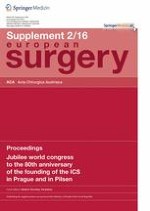Erschienen in:

27.04.2016 | ICS congress 2015
The importance of protective ileostomy during rectal resection
verfasst von:
V. Prochazkova, MD, L. Sakra, V. Cervinka, J. Flasar, J. Siller
Erschienen in:
European Surgery
|
Sonderheft 2/2016
Einloggen, um Zugang zu erhalten
Abstract
Introduction
Anastomotic leakage is one of the most important complications that occur after surgical low anterior resection for rectal cancer. Protective ileostomy or transversostomy is used during rectal resection to reduce the consequences of rectal anastomotic failures. Many studies strictly recommend performing these protective stomies for the reduction of anastomotic leakage. On the other hand, the closure of protective stomies is associated with a high morbidity rate (20 %), and the reoperation rate is 8 %. For this reason, in the Czech Republic, protective stomies are only used where generally known leakage risk factors have been presented at the Surgical Department in Pardubice.
Objective
To determine the efficacy of the protective stoma in low anterior rectal resection and to determine whether standard leakage risk factors are the appropriate criteria for providing protective stomies.
Results
In the period from January 1, 2010 to May 30, 2015 we provided 399 procedures for rectal cancer, of which 197 cases were resection types. During these rectal resections we performed 34 (17.25 %) protective ileostomies or transverstomies in cases where the leakage risk factors were presented. In the group of patients with ileostomy we detected 4 (13.3 %) patients with the complication of ileostomy; 3 (10 %) of these needed surgery. Overall, 24 anastomotic insufficiencies were noticed (12.18 %); 5 of these were in the group with the protective ileostomy. Six patients with anastomotic leakages were treated by axial transversostomy; one of these by loop ileostomy, seven patients underwent rectal amputation, two patients Hartmann resection, six patients were treated by manual or endoscopic lavage and two were just observed. However, only five protective stomies were performed in the cases where leakages were noticed.
Conclusion
Providing protective stomies in every case of rectal resection is associated with a high rate of complications, predominantly during the closure of these stomies. The use of the rectal resection leakage risk factors for indication of protective stomies represents another way to indicate protective stomies. But our experience shows that this approach is not appropriate in every case. Indication of protective stomies still remains an open question in the field of low rectal resections.